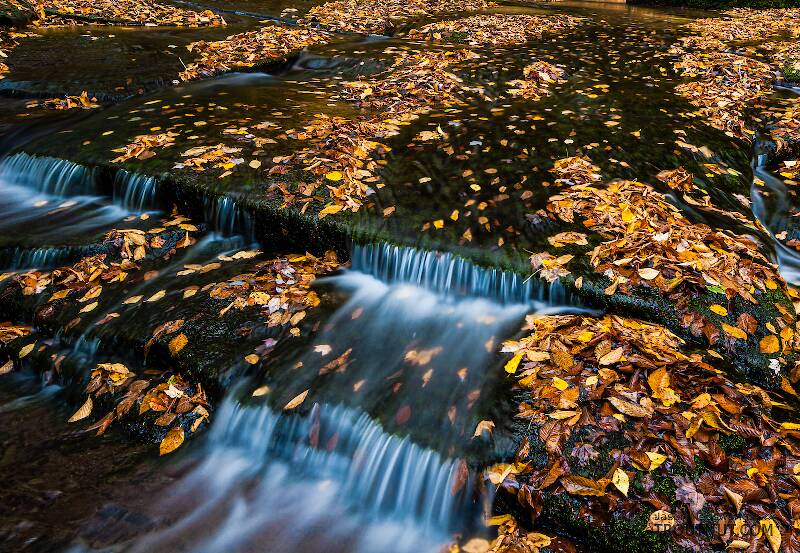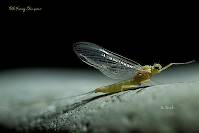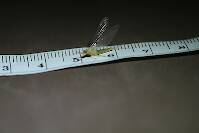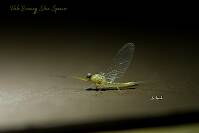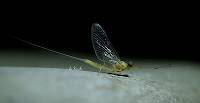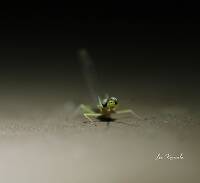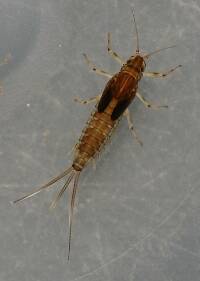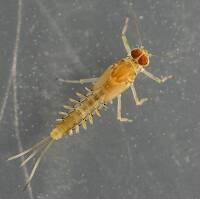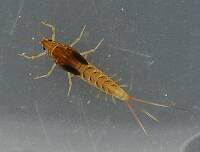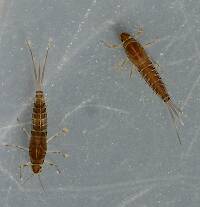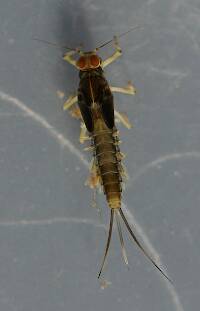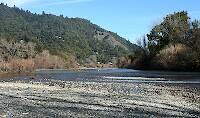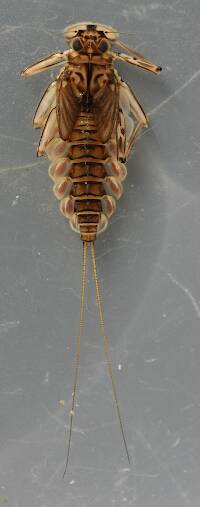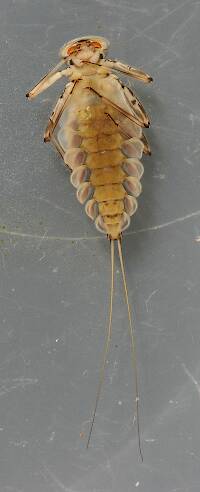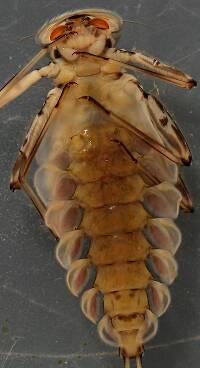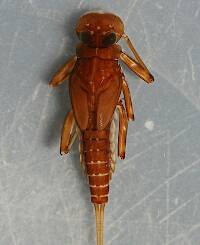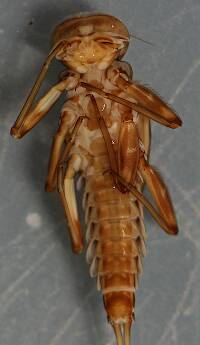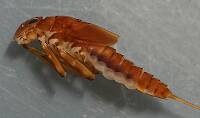
Hex Mayflies
Hexagenia limbata
The famous nocturnal Hex hatch of the Midwest (and a few other lucky locations) stirs to the surface mythically large brown trout that only touch streamers for the rest of the year.
Featured on the forum

Troutnut is a project started in 2003 by salmonid ecologist Jason "Troutnut" Neuswanger to help anglers and
fly tyers unabashedly embrace the entomological side of the sport. Learn more about Troutnut or
support the project for an enhanced experience here.
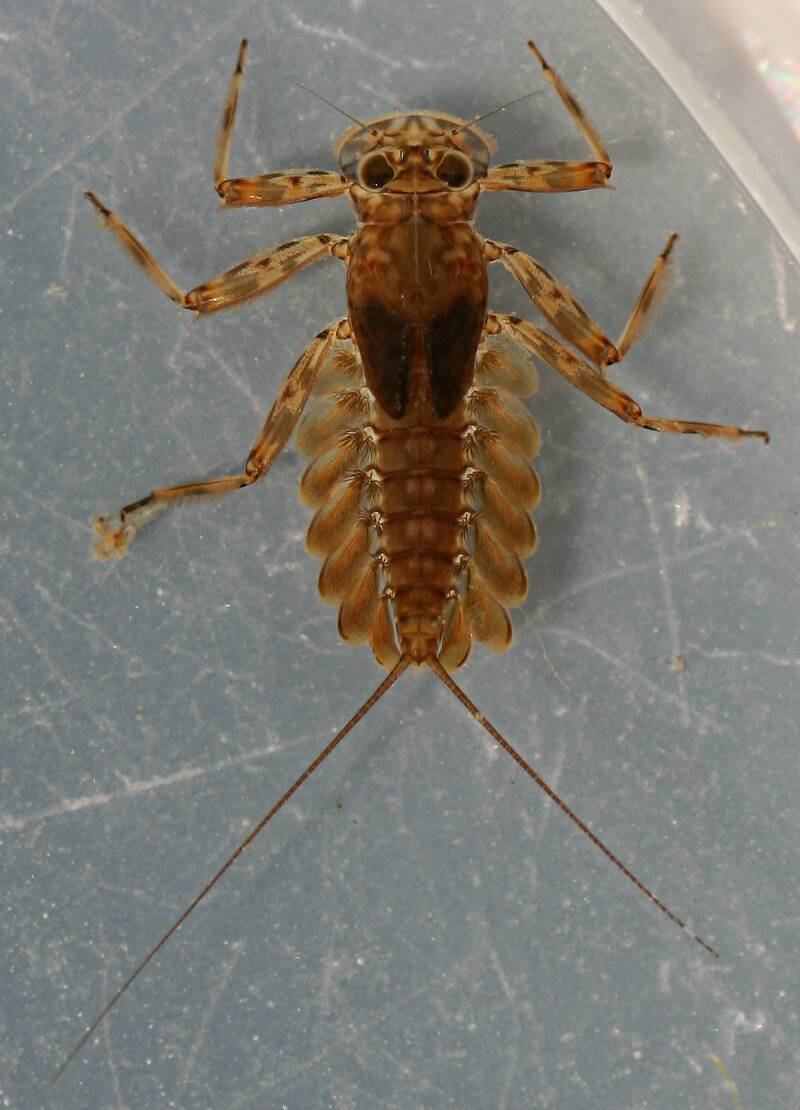
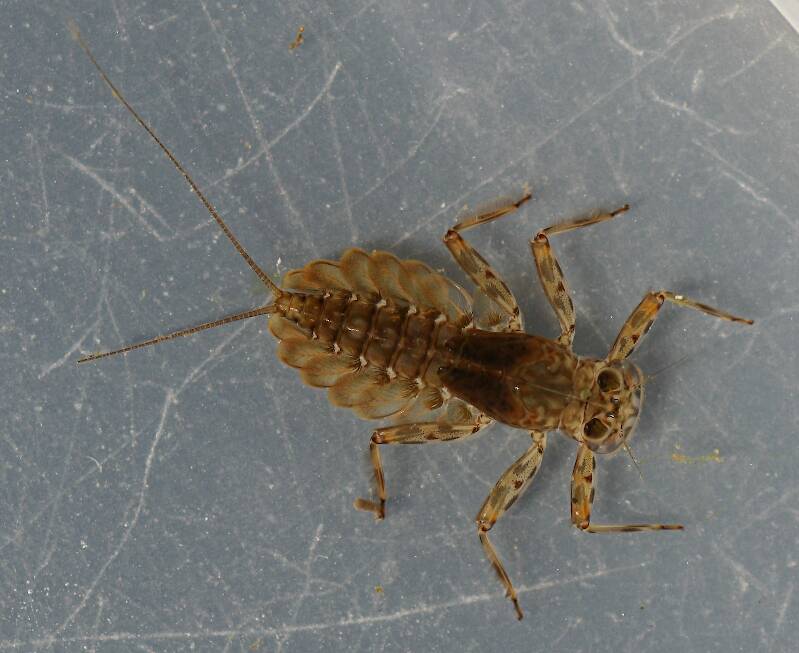
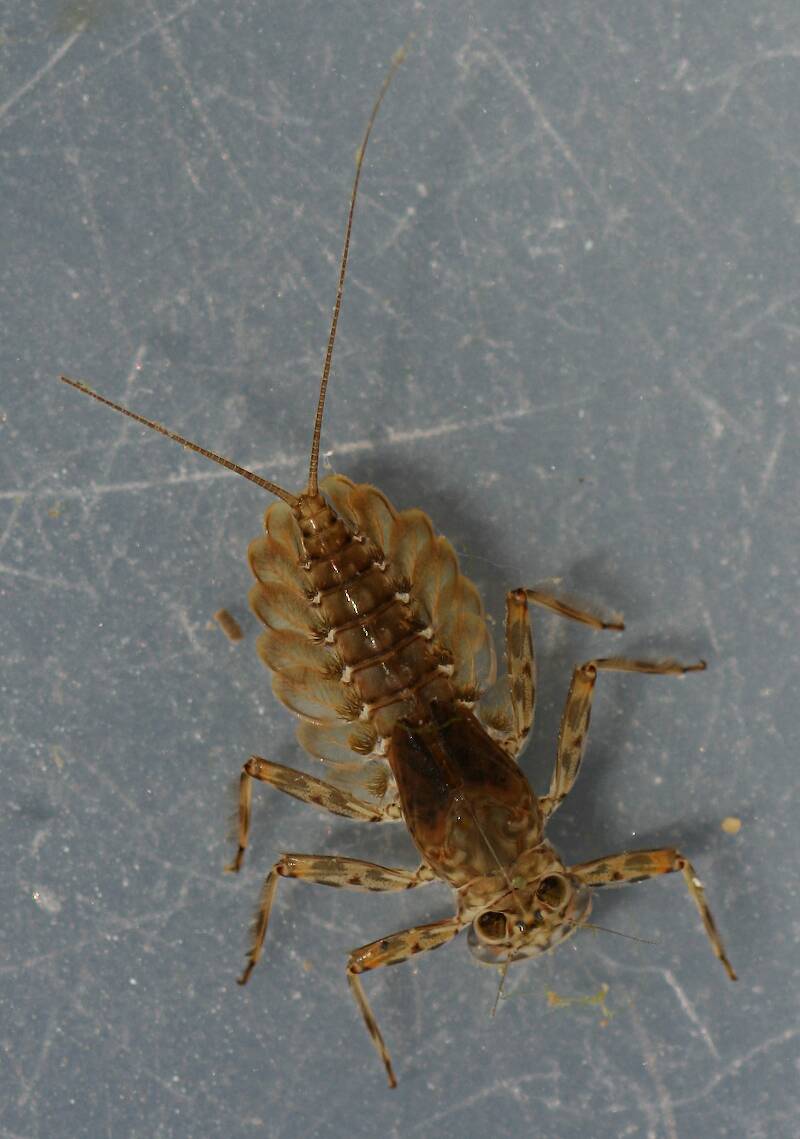
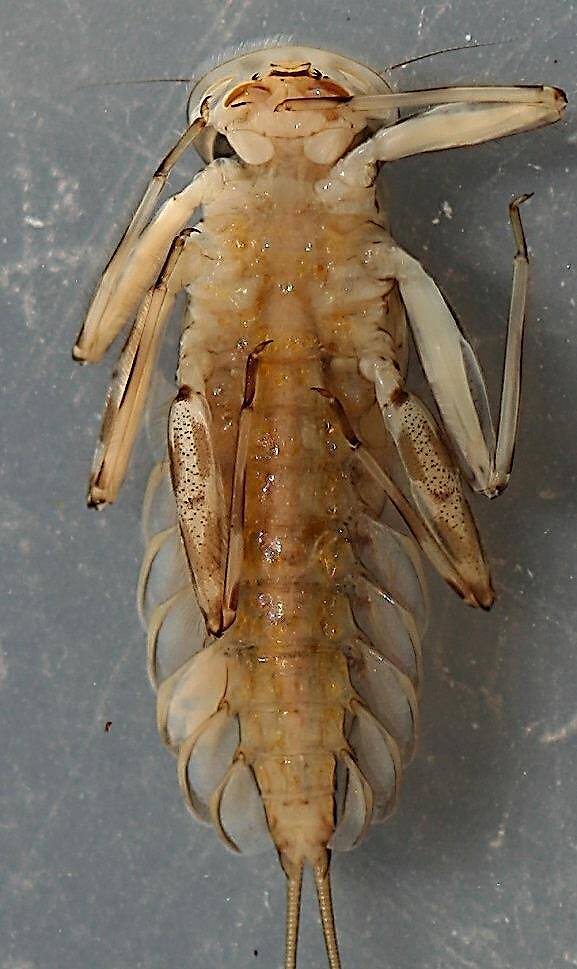
Millcreek on Jul 14, 2014July 14th, 2014, 10:25 am EDT
These are common nymphs in the Russian River, CA. I'm pretty sure they're Epeorus albertae, however there are a large number of Epeorus sp. reported in CA and some have not been described as larvae. Species that are known to occur in the state are E. albertae, E. deceptivus, E. dulciana, E. grandis, E. hesperus, E.lagunitas, E. longimanus and E.margarita. E. longimanus and E. grandis can be ruled out as their gills meet or nearly meet under the first abdominal segment and E. margarita have an acute spine at the end of the femora which the nymphs I've found do not have. E.deceptivus can probably be omitted as they lack the small dark spots on the mid-femur that this nymph has.
This leaves E. dulciana (BOLD has some photos of preserved nymphs but they're in bad shape and don't seem to show much in the way of distinguishing characteristics), E. hesperus and E. lagunitas, all of which seem to be undescribed as larvae.
I'm wondering if anyone can rule out any of the undescribed larvae, either through personal experience or info I may have missed.
This leaves E. dulciana (BOLD has some photos of preserved nymphs but they're in bad shape and don't seem to show much in the way of distinguishing characteristics), E. hesperus and E. lagunitas, all of which seem to be undescribed as larvae.
I'm wondering if anyone can rule out any of the undescribed larvae, either through personal experience or info I may have missed.
"If we knew what it was we were doing, it would not be called research, would it?"
-Albert Einstein
-Albert Einstein
Entoman on Jul 14, 2014July 14th, 2014, 6:16 pm EDT
Hi Millcreek -
Welcome to the forum. Nice to hear from a fellow Californian!
To my knowledge, your species list is both accurate and complete. I also agree with your assessment regarding species ID.
E. albertae - probable, though I can't make out the posterolateral spines in the otherwise excellent photos. . They should be long and pointy. Does have coastal distribution. Bottom line - if your critter isn't, it sure looks like one. :)
E. dulciana - can probably be eliminated for reasons of distribution. It has been reported to be an East Slope species (Day '56)
E. grandis - is a big critter. Thick, prominent tails and an emarginated head capsule make that one easy to identify. Yor specimen certainly isn't one.
E. hesperus (prev. Iron sancta-gabriel) - ditto dulciana regarding distribution issues. San Gabriel Mountains. Can be differentiated from albertae by the presence of blunt tergal posterolateral spines.
E. lagunitas - Recorded for Marin Co. so possible, I suppose. I'll look to see if i can find anything on these nymphs. Seem to remember there's something that can be helpful, like not being a big water species. I'll look... :)
E. margarita - first reported as a new species in the Rockies by Edmunds & Allen '64. Not sure about coastal distribution. It also has an acute spine at the apex of the forefemora and the terga should have an anteromedian macula. Doesn't look to be a good match.
BTW, when did you collect it and how big was it? That info is always helpful.
Best,
Welcome to the forum. Nice to hear from a fellow Californian!
To my knowledge, your species list is both accurate and complete. I also agree with your assessment regarding species ID.
E. albertae - probable, though I can't make out the posterolateral spines in the otherwise excellent photos. . They should be long and pointy. Does have coastal distribution. Bottom line - if your critter isn't, it sure looks like one. :)
E. dulciana - can probably be eliminated for reasons of distribution. It has been reported to be an East Slope species (Day '56)
E. grandis - is a big critter. Thick, prominent tails and an emarginated head capsule make that one easy to identify. Yor specimen certainly isn't one.
E. hesperus (prev. Iron sancta-gabriel) - ditto dulciana regarding distribution issues. San Gabriel Mountains. Can be differentiated from albertae by the presence of blunt tergal posterolateral spines.
E. lagunitas - Recorded for Marin Co. so possible, I suppose. I'll look to see if i can find anything on these nymphs. Seem to remember there's something that can be helpful, like not being a big water species. I'll look... :)
E. margarita - first reported as a new species in the Rockies by Edmunds & Allen '64. Not sure about coastal distribution. It also has an acute spine at the apex of the forefemora and the terga should have an anteromedian macula. Doesn't look to be a good match.
BTW, when did you collect it and how big was it? That info is always helpful.
Best,
"It's not that I find fishing so important, it's just that I find all other endeavors of Man equally unimportant... And not nearly as much fun!" Robert Traver, Anatomy of a Fisherman
Millcreek on Jul 14, 2014July 14th, 2014, 7:22 pm EDT
Entoman -
Thanks for the quick response. I'll be interested to see if you can find anything on E. lagunitas. I agree that distribution records don't match for some species but I'm always a bit leery about saying it can't be so because it hasn't been seen in the area before (probably because of hearing Dave Ruiter talking about that during discussions on Trichoptera).
Sorry about not putting in the date and size. This one was collected on July 12, 2014 and is 12 mm in length (excluding the cerci). These nymphs are common in the area from late February until August. I also forgot to mention that I've collected adults in the area and males are pretty easy to identify by genitalia.
After reading your post I went back and took a couple gills off the specimen to check the posterolateral spines. They're hard to see without removing gills but they're definitely there. That would seem to get E. hesperus out of the way.
I'm also glad to see a fellow Californian here. Should make it a little easier to ID some of the local species.
By the way, how are you on Baetis nymphs? This year I've found three species that I can't seem to ID. If you're willing to take a look I'll post them here in the next couple days.
Again, thanks for your time and effort.
Thanks for the quick response. I'll be interested to see if you can find anything on E. lagunitas. I agree that distribution records don't match for some species but I'm always a bit leery about saying it can't be so because it hasn't been seen in the area before (probably because of hearing Dave Ruiter talking about that during discussions on Trichoptera).
Sorry about not putting in the date and size. This one was collected on July 12, 2014 and is 12 mm in length (excluding the cerci). These nymphs are common in the area from late February until August. I also forgot to mention that I've collected adults in the area and males are pretty easy to identify by genitalia.
After reading your post I went back and took a couple gills off the specimen to check the posterolateral spines. They're hard to see without removing gills but they're definitely there. That would seem to get E. hesperus out of the way.
I'm also glad to see a fellow Californian here. Should make it a little easier to ID some of the local species.
By the way, how are you on Baetis nymphs? This year I've found three species that I can't seem to ID. If you're willing to take a look I'll post them here in the next couple days.
Again, thanks for your time and effort.
"If we knew what it was we were doing, it would not be called research, would it?"
-Albert Einstein
-Albert Einstein
Entoman on Jul 15, 2014July 15th, 2014, 7:36 pm EDT
How good am I with Baetis nymphs? I'll do my best...;)
You're right about distribution lists. My comments were more directed at the differences in habitat though. Large warm rivers like the Russian are habitats prefered by few Epeorus species. E. albertae is right at home in that kind of water. Those triangular marks on the femora are also something I've only seen on this species. That and the prodigious numbers you report are fairly indicative of this common species and the time of year and size are right... The adults you mention are important. Try to capture a few black wings for rearing to imagos. The association may tell us more.
You're right about distribution lists. My comments were more directed at the differences in habitat though. Large warm rivers like the Russian are habitats prefered by few Epeorus species. E. albertae is right at home in that kind of water. Those triangular marks on the femora are also something I've only seen on this species. That and the prodigious numbers you report are fairly indicative of this common species and the time of year and size are right... The adults you mention are important. Try to capture a few black wings for rearing to imagos. The association may tell us more.
"It's not that I find fishing so important, it's just that I find all other endeavors of Man equally unimportant... And not nearly as much fun!" Robert Traver, Anatomy of a Fisherman
Millcreek on Jul 16, 2014July 16th, 2014, 7:27 am EDT
E. albertae is certainly the dominant Epeorus species in this area of the Russian. The only other Epeorus I've found here is E. longimanus and it appears earlier in the year (usually shows up in February and is gone by May).
The adults of E. albertae are interesting, usually appear in the evening, males first and females joining the swarm a bit later. Only mayflies I've seen mating in flight. I'm sure others do as well but these are really shameless.
I'm not set up for rearing right now but hope to be next year. Hope to give them a try then.
Just got an unpublished manual by Jacobus, Wiersema and Webb on ID of western and northern mayflies for a SAFIT workshop. Given the state of taxonomy on Epeorus they've opted to lump E. albertae, E. dulciana, E. hesperus, E. lagunitas and E. margarita into something called the Epeorus albertae group. Still inclined to believe it's E. albertae myself.
The adults of E. albertae are interesting, usually appear in the evening, males first and females joining the swarm a bit later. Only mayflies I've seen mating in flight. I'm sure others do as well but these are really shameless.
I'm not set up for rearing right now but hope to be next year. Hope to give them a try then.
Just got an unpublished manual by Jacobus, Wiersema and Webb on ID of western and northern mayflies for a SAFIT workshop. Given the state of taxonomy on Epeorus they've opted to lump E. albertae, E. dulciana, E. hesperus, E. lagunitas and E. margarita into something called the Epeorus albertae group. Still inclined to believe it's E. albertae myself.
"If we knew what it was we were doing, it would not be called research, would it?"
-Albert Einstein
-Albert Einstein
Entoman on Jul 16, 2014July 16th, 2014, 9:16 am EDT
Yeah, I was going to mention that there is much work to be done with this species group. There may be a possibility that synonymies are in their future, as has happened to other "species" that hadn't had their genetics analyzed or their nymphs associated.
All you need to rear ripe nymphs is a bowl, a stick, and some screening. Since they often hatch within hours of capture, I've successfully used a plastic cup and a napkin before. Rearing immatures (especially heptageniids) is an undertaking of a wholy different order of magnitude! :)
All you need to rear ripe nymphs is a bowl, a stick, and some screening. Since they often hatch within hours of capture, I've successfully used a plastic cup and a napkin before. Rearing immatures (especially heptageniids) is an undertaking of a wholy different order of magnitude! :)
"It's not that I find fishing so important, it's just that I find all other endeavors of Man equally unimportant... And not nearly as much fun!" Robert Traver, Anatomy of a Fisherman
Entoman on Jul 16, 2014July 16th, 2014, 11:07 am EDT
Just got an unpublished manual by Jacobus, Wiersema and Webb on ID of western and northern mayflies for a SAFIT workshop. Given the state of taxonomy on Epeorus they've opted to lump E. albertae, E. dulciana, E. hesperus, E. lagunitas and E. margarita into something called the Epeorus albertae group.
Yes, that is an excellent resource! Luke Jacobus is a good friend and fellow contributor here. He goes by Konchu. Jeff Webb also contributes and goes by Jmw975.
"It's not that I find fishing so important, it's just that I find all other endeavors of Man equally unimportant... And not nearly as much fun!" Robert Traver, Anatomy of a Fisherman
Millcreek on Jul 16, 2014July 16th, 2014, 12:23 pm EDT
Thanks for the advice on rearing blackpad nymphs. I was down at the river this morning and quite a few of the nymphs looked like they would be prime candidates for your method. If I can get some males out of it it would go a long ways toward clarifying the question of which Epeorus species it is.
I was happy to get the manual from Luke Jacobus. I only got it a couple days ago and so haven't had a chance to go over it thoroughly yet. Looks to be a good way to see what the state of taxonomy is in the area described.
I was happy to get the manual from Luke Jacobus. I only got it a couple days ago and so haven't had a chance to go over it thoroughly yet. Looks to be a good way to see what the state of taxonomy is in the area described.
"If we knew what it was we were doing, it would not be called research, would it?"
-Albert Einstein
-Albert Einstein
Entoman on Jul 16, 2014July 16th, 2014, 1:26 pm EDT
Yep. Species are concepts...
"It's not that I find fishing so important, it's just that I find all other endeavors of Man equally unimportant... And not nearly as much fun!" Robert Traver, Anatomy of a Fisherman
Oldredbarn on Jul 16, 2014July 16th, 2014, 3:10 pm EDT
Yes, that is an excellent resource! Luke Jacobus is a good friend and fellow contributor here. He goes by Konchu. Jeff Webb also contributes and goes by Jmw975.
Add in Roger, Dave, and Kurt and you have the "gang" we here affectionately call "The Bug Boys".
Spence
"Even when my best efforts fail it's a satisfying challenge, and that, after all, is the essence of fly fishing." -Chauncy Lively
"Envy not the man who lives beside the river, but the man the river flows through." Joseph T Heywood
"Envy not the man who lives beside the river, but the man the river flows through." Joseph T Heywood
Millcreek on Jul 16, 2014July 16th, 2014, 4:58 pm EDT
Hi Spence,
Nice to know who the players are in the "Bug Boys". I've bothered Luke Jacobus a few times with questions on mayflies and he's always been helpful.
Only know Jim Webb from papers he's been author or co-author of.
Dave I know from having picked his brain about various species of Trichoptera and Roger I'm aware of from BugGuide and of course Kurt as Entoman. I can see I'll have to step up my game here.
Mark
Nice to know who the players are in the "Bug Boys". I've bothered Luke Jacobus a few times with questions on mayflies and he's always been helpful.
Only know Jim Webb from papers he's been author or co-author of.
Dave I know from having picked his brain about various species of Trichoptera and Roger I'm aware of from BugGuide and of course Kurt as Entoman. I can see I'll have to step up my game here.
Mark
"If we knew what it was we were doing, it would not be called research, would it?"
-Albert Einstein
-Albert Einstein
Oldredbarn on Jul 17, 2014July 17th, 2014, 7:28 am EDT
I can see I'll have to step up my game here.
Mark
No...They are a sharing bunch...It's all about learning here with them. Everyone knows that entomology isn't the glamour science and everything counts in terms of us all figuring it all out.
They have spun my head around a few times by moving some of my favorites around and changing their names, but Roger keeps us amateurs up to speed with his updates and lists. It just takes a little effort and he's done the hard part.
I must admit that I'm not looking forward to the day when DNA analysis turns a Pale Watery or a Little Slate-Winged Olive into a digital something or other like DN123 or some such. When the romance leaves my obsession they can plant me in the soil or spread my ashes along my beloved Au Sable. :)
Mark...Welcome, by-the-way!
Spence
You know, we have only had to chain one of the Bug Boys ankles to the floor, and that has only happened a very few times...We finally got Kurt to cool it on the morning coffee and he's been just fine ever since...;)
"Even when my best efforts fail it's a satisfying challenge, and that, after all, is the essence of fly fishing." -Chauncy Lively
"Envy not the man who lives beside the river, but the man the river flows through." Joseph T Heywood
"Envy not the man who lives beside the river, but the man the river flows through." Joseph T Heywood
Taxon on Jul 17, 2014July 17th, 2014, 9:01 am EDT
Hi Mark-
Am compelled to observe that both your aquatic insect photography and your id research are outstanding. Welcome aboard.
Am compelled to observe that both your aquatic insect photography and your id research are outstanding. Welcome aboard.
Millcreek on Jul 17, 2014July 17th, 2014, 9:47 am EDT
Roger -
Thank you. I've seen your work on BugGuide and on Flyfishing Entomology and have been impressed by it. Which reminds me I need to change Centroptilum bifurcatum to Anafroptilum bifurcatum on BugGuide.
Mark
Thank you. I've seen your work on BugGuide and on Flyfishing Entomology and have been impressed by it. Which reminds me I need to change Centroptilum bifurcatum to Anafroptilum bifurcatum on BugGuide.
Mark
"If we knew what it was we were doing, it would not be called research, would it?"
-Albert Einstein
-Albert Einstein
Millcreek on Jul 17, 2014July 17th, 2014, 10:09 am EDT
Spence -
Regarding your remarks on DNA analysis: I share some of your feelings on the subject. Fieldwork is the part of researching I enjoy most and it doesn't seem DNA analysis has much application there. On the other hand, if it's possible to combine DNA analysis with written keys, illustrations and photography it may help understanding individual species and how they are related to others. I'm sure it will uncover new species and hopefully shed light on known species. Probably create new complications as well.
That said, if it does come to referring to some species as DNA123 it would be pretty dismal. Not nearly as poetic as flyfisher's colloquialisms or Latin binomials.
Mark
Regarding your remarks on DNA analysis: I share some of your feelings on the subject. Fieldwork is the part of researching I enjoy most and it doesn't seem DNA analysis has much application there. On the other hand, if it's possible to combine DNA analysis with written keys, illustrations and photography it may help understanding individual species and how they are related to others. I'm sure it will uncover new species and hopefully shed light on known species. Probably create new complications as well.
That said, if it does come to referring to some species as DNA123 it would be pretty dismal. Not nearly as poetic as flyfisher's colloquialisms or Latin binomials.
Mark
"If we knew what it was we were doing, it would not be called research, would it?"
-Albert Einstein
-Albert Einstein
Entoman on Jul 17, 2014July 17th, 2014, 5:51 pm EDT
Hey - I resemble that remark, Spence. :)
It may be in my neck of the woods, but I don't know much about the Russian. Played in it one Summer with a girlfriend back in the '70s. Her folks had a cabin on the river and ... Well, not a story on topic. It's upper reaches in the redwoods are both beautiful and unique. I'll let Mark address the fishing, but the River's heyday was just a few years before me. Legends like Bill Schadt and others sadly watched its once mighty steelhead runs give up the ghost before I had the chance... :(
Mark -
Anafroptilum? Yes, I've got a lot of editing to do in the encyclopedia as well.:) Thanks for pointing it out. Centroptillium is gone, boys. It seems like only yesterday that editing some of its species into Procloeon was completed. Man, this is moving fast...
BTW Spence, Luke did the dirty deed last month.:)
It may be in my neck of the woods, but I don't know much about the Russian. Played in it one Summer with a girlfriend back in the '70s. Her folks had a cabin on the river and ... Well, not a story on topic. It's upper reaches in the redwoods are both beautiful and unique. I'll let Mark address the fishing, but the River's heyday was just a few years before me. Legends like Bill Schadt and others sadly watched its once mighty steelhead runs give up the ghost before I had the chance... :(
Mark -
Anafroptilum? Yes, I've got a lot of editing to do in the encyclopedia as well.:) Thanks for pointing it out. Centroptillium is gone, boys. It seems like only yesterday that editing some of its species into Procloeon was completed. Man, this is moving fast...
BTW Spence, Luke did the dirty deed last month.:)
"It's not that I find fishing so important, it's just that I find all other endeavors of Man equally unimportant... And not nearly as much fun!" Robert Traver, Anatomy of a Fisherman
Oldredbarn on Jul 17, 2014July 17th, 2014, 7:37 pm EDT
"You say Anafroptilum, I say Centroptillium, Lets call the whole thing off..." :)
I have seen some up on the N Branch of the Au Sable. Can't say I've seen any fish taking them, had the feeling they were hatching in the middle of the night. My impression was of a 20/22 sulpher. Watched them from the inside of the Riverside Tavern in Lovell's...A trout's eye view...only slightly blurred due to my love of Canadian beers...
Creamy yellow with split tails.
Not a scientific observation. :)
Spence
I have seen some up on the N Branch of the Au Sable. Can't say I've seen any fish taking them, had the feeling they were hatching in the middle of the night. My impression was of a 20/22 sulpher. Watched them from the inside of the Riverside Tavern in Lovell's...A trout's eye view...only slightly blurred due to my love of Canadian beers...
Creamy yellow with split tails.
Not a scientific observation. :)
Spence
"Even when my best efforts fail it's a satisfying challenge, and that, after all, is the essence of fly fishing." -Chauncy Lively
"Envy not the man who lives beside the river, but the man the river flows through." Joseph T Heywood
"Envy not the man who lives beside the river, but the man the river flows through." Joseph T Heywood
Entoman on Jul 18, 2014July 18th, 2014, 4:35 am EDT
The only constant is change, but for the last several years these tiny mayflies have been the dominant Summer hatches on the middle reaches of Fall River. It has gone unreported (or rather misreported as PMD hatches). They provide excellent fishing hatching midday for several hours. They are on the water in significant numbers from late July through to Fall until the baetids & Mahoganies take over. When you hear reports of little PMD's out West below size 18, suspect these little guys as the culprits.
"It's not that I find fishing so important, it's just that I find all other endeavors of Man equally unimportant... And not nearly as much fun!" Robert Traver, Anatomy of a Fisherman
Oldredbarn on Jul 18, 2014July 18th, 2014, 6:59 am EDT
The only constant is change, but for the last several years these tiny mayflies have been the dominant Summer hatches on the middle reaches of Fall River. It has gone unreported (or rather misreported as PMD hatches). They provide excellent fishing hatching midday for several hours. They are on the water in significant numbers from late July through to Fall until the baetids & Mahoganies take over. When you hear reports of little PMD's out West below size 18, suspect these little guys as the culprits.
Kurt...I remember running into this on DePuy's & Armstrong's back during the summer of 1995. I may have my notes somewhere...I remember some shoulder shrugging going on back them. My buddy back home, who had spent some time out there in the 70's called it correctly.
Spence
"Even when my best efforts fail it's a satisfying challenge, and that, after all, is the essence of fly fishing." -Chauncy Lively
"Envy not the man who lives beside the river, but the man the river flows through." Joseph T Heywood
"Envy not the man who lives beside the river, but the man the river flows through." Joseph T Heywood
Millcreek on Jul 18, 2014July 18th, 2014, 7:43 am EDT
Kurt and Spence - On the Russian Anafroptilum bifurcatum adults show up in large swarms twice a year, April-July and again from September through November. Swarms of males show up by late afternoon or early evening over gravel bars or at the edge of the water and females show up in smaller groups a bit later over fast glides and riffles to lay their eggs. They're present in large enough numbers that it's a bit like standing in a yellow snowstorm. No jokes about yellow snow, Spence.
The nymphs are beautiful little animals. If you are interested in photos of the nymphs I'll post some. Not quite sure where to post them though since it's not an ID request. Any suggestions welcome.
The nymphs are beautiful little animals. If you are interested in photos of the nymphs I'll post some. Not quite sure where to post them though since it's not an ID request. Any suggestions welcome.
"If we knew what it was we were doing, it would not be called research, would it?"
-Albert Einstein
-Albert Einstein
Quick Reply
Related Discussions
Topic
Replies
Last Reply
5
Sep 10, 2020
by Leskorcala
by Leskorcala
1
Oct 28, 2008
by GONZO
by GONZO
16
May 20, 2008
by Shawnny3
by Shawnny3

